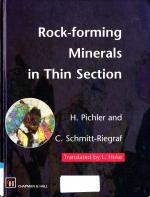Добрый день, Коллеги. Важное сообщение, просьба принять участие. Музей Ферсмана ищет помощь для реставрационных работ в помещении. Подробности по ссылке
Rock-forming minerals in thin section / Породообразующие минералы в шлифах
The use of a polarizing microscope is still an essential tool for every earth scientist who does petrographic work. No student in mineralogy, petrography and petrology, geology and mining geology should leave university without knowledge of this fundamental method for determining minerals and rocks, which in 1850 revolutionized our science and placed it on firm foundations.
In German geological literature, this is the first short comprehensive teaching book about using a microscope in the identification of minerals for at least fifty years. The classic German works of this kind, such as those by Weinschenk (1915) and Chudoba (1932), opened up polarizing microscopy to earlier generations, including one of the authors (H.P.) These have long been out of print and outdated. Therefore, in order to close this gap and to provide future earth scientists with guidelines in practical microscopy, we have compiled these notes, which have been used and developed over many years at the Mineralogical Institute in Tubingen. In writing this book the following guidelines were used:
1. The contents focus on rock-forming minerals. In our selection, we have been generous and have also included some rare minerals, such as perovskite, pyrochlore, koppite, cancrinite, etc. We selected those minerals that are familiar, occur in rocks of central Europe, and that are well represented in rock collections. The rare minerals occur in volcanic and subvolcanic rocks of the Kaiserstuhl, the Hegau, Schwabische Alb and in the Laacher volcanic areas of Germany.
2. We give emphasis to the common minerals. They are shown in the tables in bold letters; the less common and not so important minerals are shown in normal type. Rare minerals and also special rock-forming minerals which belong to salt and clay-rich rocks and soils are not covered in this book; we refer the reader to more specialized books, in particular Troger (1982,1969). The Troger edition (1969), unfortunately out of print, is recommended as an essential reference book.
3. Important data are presented in table form.
The tables at the end of the book complement the more descriptive text, which the microscope user should use in the identification of minerals. Tables 6 and 7a-7d are particularly useful.
4. In order to make it easier for the beginner we start off with the principles of polarization microscopy. This part is short and places emphasis on the practical applications. The microscope user should know which observations can and should be made in plane-polarized light and which ones in crossed polarized fight; how to determine the optical character of the optical elongation; what straight, symmetric and inclined extinctions are, and how to make observations in the conoscopic path of light. Comprehending indicatrix models requires knowledge of the relationship between crystal symmetry and its optical characteristics. All these points are covered in the first part of this book. Literature for further reading about polarization microscopy is listed in the Bibliography. In particular we recommend the clearly written, very practical small book by Muller and Raith (1987).
5. Importance of paragenesis. The coexistence of certain minerals in assemblages is characteristic for most rocks. For instance, as a general rule, if a volcanic rock contains a mineral of the sodalite group then quartz will not be present. However, minerals such as nephefine, leucite, aegirine-augite and melanite can be expected. Consideration of possible paragenesis can help in the search and identification of minerals.
6. Photomicrographs and black and white diagrams. We have tried to show all minerals described here either as a drawing (by C. S.-R.) or as a photomicrograph (by Manfred Pfleghaar).
We are pleased that, through this translation, it has been possible to bring this book to the attention of the English-speaking mineralogy community.




